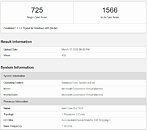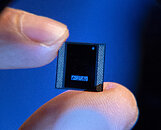Monday, March 23rd 2020

Intel Core i5-L15G7 Lakefield Processor Spotted
Intel has been experimenting with a concept of mixing various types of cores in a single package with a design called Lakefield. With this processor, you would get a package of relatively small dimensions that are 12-by-12-by-1 millimeters withing very low TDP. Thanks to the Twitter user InstLatX64 (@InstLatX64) we have some GeekBench 5 results of the new Lakefield chip. The CPU in question is the Core i5-L15G7, a 5 core CPU without HyperThreading. The 5C/5T would be a weird configuration if only Lakefield wasn't meant for such configs. There are one "big" Sunny Cove core and four "small" Tremont cores built on the 10 nm manufacturing process. This is the so-called compute die, where only the CPU cores are present. The base dies containing other stuff like I/O controllers and PHYs, memory etc. is made on a low-cost node like 22 nm, where performance isn't the primary target. The whole chip is targeting the 5-7 W TDP range.
In the GeekBench 5 result we got, the Core i5-L15G7 is a processor that has a base frequency of 1.4 GHz, while in the test it reached as high as 2.95 GHz speeds. This is presumably for the big Sunny Cove cores, as Tremont cores are supposed to be slower. The cache configuration reportedly puts 1.5 MB of L2$ and 4 MB of L3$ for the CPUs. If we take a look at performance numbers, the chip scores 725 points in single-core tests, while the multi-core result is 1566 points. We don't know what is the targeted market and what it competes with, however, if compared to some offerings from Snapdragon, like the Snapdragon 835, it offers double the single-threaded performance with a similar multi-core score. If this is meant to compete with the more powerful Snapdragon offerings like the 8cx model, comparing the two results in Intel's fail. While the two have similar single-core performance, the Snapdragon 8cx leads by as much as 76.9% in a multi-core scenario, giving this chip a heavy blow.
Source:
Tom's Hardware
In the GeekBench 5 result we got, the Core i5-L15G7 is a processor that has a base frequency of 1.4 GHz, while in the test it reached as high as 2.95 GHz speeds. This is presumably for the big Sunny Cove cores, as Tremont cores are supposed to be slower. The cache configuration reportedly puts 1.5 MB of L2$ and 4 MB of L3$ for the CPUs. If we take a look at performance numbers, the chip scores 725 points in single-core tests, while the multi-core result is 1566 points. We don't know what is the targeted market and what it competes with, however, if compared to some offerings from Snapdragon, like the Snapdragon 835, it offers double the single-threaded performance with a similar multi-core score. If this is meant to compete with the more powerful Snapdragon offerings like the 8cx model, comparing the two results in Intel's fail. While the two have similar single-core performance, the Snapdragon 8cx leads by as much as 76.9% in a multi-core scenario, giving this chip a heavy blow.


47 Comments on Intel Core i5-L15G7 Lakefield Processor Spotted
Anyway lets hope for the best and see where this particular processor is going to end up. For what OP said, it is really hard to hold your breath. The numbers show something different than what you say.
Given this is a leak, not a release CPU or system, it is quite likely that things are not going right.
If I had to guess, this single-core score is from one of the Atom cores.
No, it's not.I never said that either.I'm not sure how you draw the line between laptops and tablets. Keyboard? Processing power?
The idea behind hybrid architecture is extremely simple.
If you're buying a high-end desktop CPU, you're probably getting the fastest single-thread performance an architecture offers. That's because high-end desktop users aren't really concerned with power consumption. So even if you're doing single-thread tasks most of the day (which is true for most people), you're not harmed in any way. You've paid for 8 cores, you use 1. It's still fast. You get fast browsing, fast software, responsive OS. Great.
If you're buying pretty much any other consumer PC, there's always a single-thread performance compromise. It doesn't matter if it's 35W or 15W or 6W.
A single core CPU makes no sense because of platform stability. You get at least 2. They have to split the die size and power budget.
On the other hand, you end up with large cores anyway. So even in idle, they'll draw more power than is needed.
The hybrid architecture fixes everything.
You get a single massive core that can use most of the power budget - so single-thread tasks run almost as fast as on a single-core chip OR a much larger chip with faster cores.
And you get a smaller core that is extremely frugal, yet powerful enough to support PC's basic functions.
For now we're only see these hybrid SoCs in mobile devices, because that's the priority market (and the implication is more substantial).
But there's no reason why they would not be used in desktops or even small servers (NAS etc) in the future.
A homogeneous architecture just isn't the optimal solution. It never was.
:D
From the OP's text:
"if compared to some offerings from Snapdragon, like the Snapdragon 835, it offers double the single-threaded performance with a similar multi-core score. If this is meant to compete with the more powerful Snapdragon offerings like the 8cx model, comparing the two results in Intel's fail. While the two have similar single-core performance, the Snapdragon 8cx leads by as much as 76.9% in a multi-core scenario, giving this chip a heavy blow. "
This is EXACTLY what I'm saying. Different, much more useful scaling between single and multi thread. You get twice as much performance in single-thread.
And it's x86, so it can run way more software.
Yes, i5-L15G7 is not as fast as the halo Snapdragon. But you can't dis a product just because it isn't the best in the world.
i5 is the mainstream, money-making range of Intel's product.
ARM and x86 are different platforms.
Comparing to high-end Snapdragons is fine for products that could use either.
Keep in mind that even today, with ARM chips being so obviously efficient and fast (Snapdragon 835 is almost 3 years old), a lot of devices stick to cheap x86 parts (e.g. NAS and cheap laptops - even Chromebooks!). It's a much more robust and easier to use platform.
Since most products will keep using x86 hearts, we should compare to the x86 chips that are used today. That's why I'm mentioning <10W Celerons all the time, not high-end Snapdragons (even if they cost roughly the same).
And the improvement here would be enormous.My main concern is single-thread performance in this power envelop. It's really game changing.
Because pushing fast low-power x86 CPUs would be a significant achievement. Intel tried a few times with mixed success. Lakefield is the most extreme and interesting approach to date.
Imagine this. It is 3 years old CPU and still give Intel's brand new chip stimulus. Isn't that something worth mentioning? Intel is trying doing something and kudos for that but it would seem, Intel still has to catch up a bit or improve.Sure it is but it has to be fast enough. You think this one is? I really wanna share your enthusiasm but I'd rather wait.
Remember the squared bit? It's not hard.
Or what are you talking about? :D
Edit: LMGTFY
You've proved me right, and you agree with my math, then tell me i'm wrong lol.
I'm seriously curious how you're thinking.You were the one who didn't agree that 12 mm x 12 mm = 144 mm².
I've never changed my point of view.